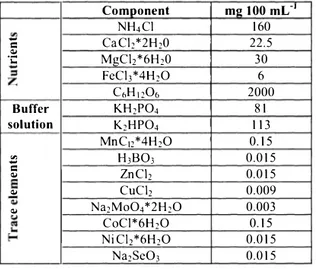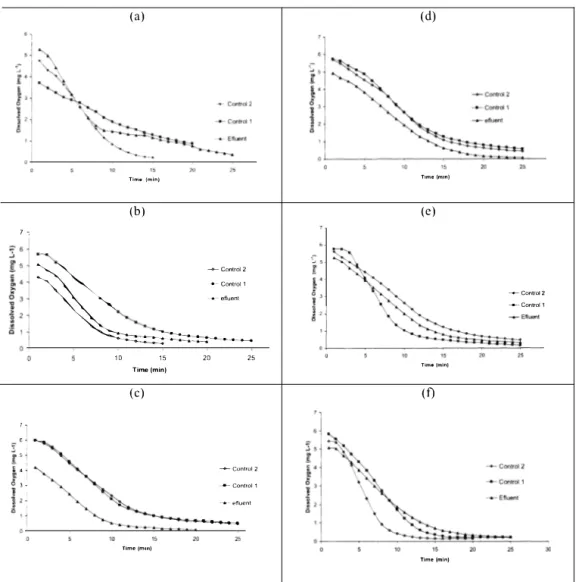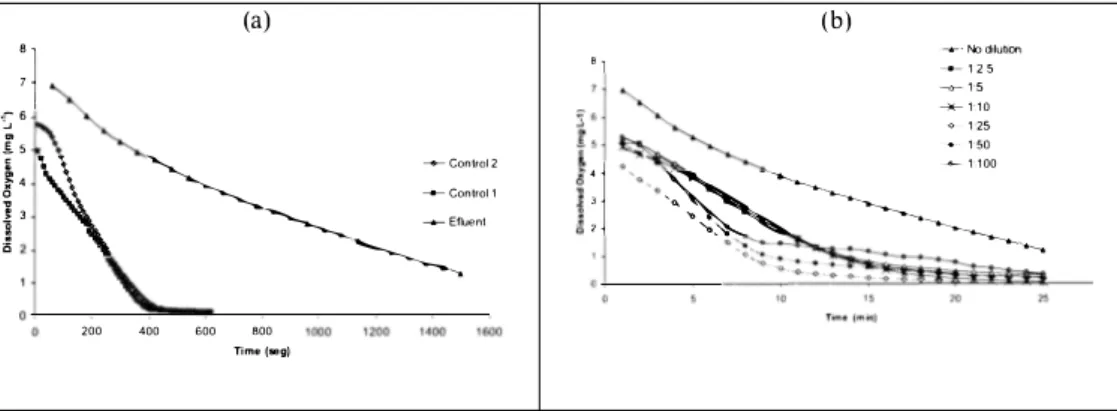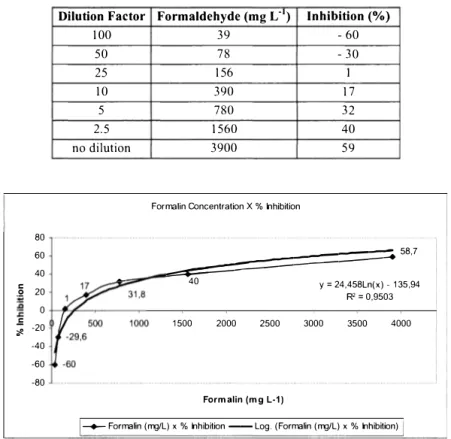�,, • �,, Kalmar ECO-TECH '07
KALMAR, SWEDEN, November 26-28, 2007
THE USE OF RESPIROMETRY FOR THE
EVALUATION OF AN INDUSTRIAL
WASTEWATER TOXICITY OVER ACTIVATED
SLUDGE
Fabio Kaczala
1' 11 3
1rJarc1a 1rJarques
William Hogland
11
University of Kalmar, Sweden
1
The CAPES Foundation, Brazil Ministry of Education,
Brazil
3
Rio de Janeiro State University-UERJ, Brazil
ABSTRACT
The discharge of industrial wastewaters with toxic substances in wastewater treatment plants may cause relevant inhibition of microbiological metabolism. A number of toxicity tests available mostly focus on ecological impacts on water recipients by using macro invertebrates as bio-indicators. However, toxic effects occurring in wastewater treatment plants cannot be properly addressed with this approach. A promising method that has been used to investigate microbiological inhibition caused by industrial wastewaters is,.the respirometric test. As part of a treatability study, the present investigation aimed to assess the toxic effects of an industrial wastewater generated in a wood-floor industry, located in Nybro, Sweden over activated sludge microorganisms. The wastewater results from washing/cleaning of machineries that continuously apply urea-formaldehyde resins on wood particle boards. The respirometric method was able in a short time to assess both the inhibition and the stimulation of microbial metabolism caused by this particular tested effluent. Metabolic inhibition was positively correlated with dilution factors and formaldehyde concentrations within the aqueous phase. Whereas 1,989.4 mg L"1 of formaldehyde caused 50% of metabolic inhibition, concentrations below 156 mg L"1 did stimulate it. High EC50 values suggest that in the presence of other compounds, antagonistic processes are taking place, reducing toxic effects of formaldehyde. Finally it was concluded that toxicity tests carried out with single substances in synthetic waters have limited value if the ultimate goal is to develop real wastewater treatment systems. It is important to highlight that formaldehyde was here used as an indicator and the correlation between inhibition of respiration and formaldehyde concentration is
-Kalmar ECO-TECH ·07 KALMAR. SWEDEN. November 26-28. 2007 I. INTRODUCTION
wastewater [2], most efforts carried out to date have concentrated on the toxic impacts of direct discharges into the natural water environment [3], Moreover, toxic effects over microbial metabolism in wastewater treatment plants have traditionally been addressed for Adequate knowledge of the negative effects of toxins and inhibitors in any biological wastewater treatment system is essential for an optimal application of the processes [ I l However, although toxic and microbial inhibitory compounds are usually found in industrial
individual-isolated substances [3,4]. In reality, effluents, particularly industrial ones, are complex mixtures of organic and inorganic compounds with specific interactions among them. Assessing the properties and effects of isolated compounds has limited merits. considering the possibility of either synergistic or antagonistic effects. Whereas antagonism is the condition in which the toxic effects caused by one compound are reduced by the presence of a second one, synergism, is the condition where the toxic effects caused by the original compound are increased by the presence of a second compound in the system [I].
The present investigation aimed to evaluate the toxic effects of a real industrial wastewater over microbial populations found in the activated sludge of a wastewater treatment plant Although, the correlation between formaldehyde concentrations and toxicity was the main focus, the "whole effluent approach" suggested by [4] was followed. By testing a real effluent generated by a wood floor industry and observing the result of the interactive processes occurring among different compounds, the toxicity could be assessed as close as possible to the real scenario. Toxicity data related to formaldehyde as a single compound - widely reported in the literature - was here used in order to compare the isolate toxicity effects with the effects on the presence of different compounds.
2. MATERIAL AND METHODS
Industrial effluent (glue wastewater): The wastewater studied is generated during procedures of cleaning/ washing of machineries that continuously apply urea-formaldehyde resins on wood particle boards, at the wood floor industry AB Gustaf Kahr located in Nybro, Sweden. Samples of the studied effluent were taken just after the cleaning procedure and sent immediately to the laboratory. Formaldehyde was analyzed with the VOi Vorschrift method. Activated sludge: The activated sludge used for these experiments was taken from Kalmar Municipal Wastewater Treatment Plant, Kalmar, Sweden. The mixed liquor volatile suspended solids - ML VSS ranged between 3.98-4.2 g L-1•
Synthetic medium: In each experimental batch, I L of activated sludge was spiked with a synthetic medium according to Table I.
Kalmar ECO-TECH '07
KALMAR. SWEDEN. November 26-28, 2007
Table 1 _- Synthetic medium used for rc,1piromctric test in each 100 ml of activated sludge,
c
"'
·.:::
Buffer solution ,.,,c
"'
"'
"'
Component m2 100 mL-' NH4Cl 160 CaCl2*2H20 22,5 MgCb*6H20 30 FcCli*4H2O 6 CoH12O6 2000 KH2PO4 81 K2HPO4 113 MnC12*4H2O 0.15 H1BO1 0,015 ZnC}i 0,015 CuC}i 0.009 Na2MoO4*2H2O 0.003 C0Cl*6H2O 0.15 NiCV6H2O 0.015 Na2ScOi 0.015Respirometry: A toxicity test based on respirometric method was set-up on the basis of the
established OECD Method 209 [5], which provides a screening procedure to indicate suitable non-inhibitory concentrations to be used in biodegradability tests. The original procedure established in the method was slightly modified, since the method is not appropriate for testing VOCs due losses that occurs as a consequence of continuous aeration on the test beacker.
Experimental Procedures:Each batch of respirometry was conducted in three different 600
ml-beackcr as described below:
• Control 1 and Control 2: (synthetic medium + 100 mL activated sludge + I 50 mL distilled water);
• Test: (synthetic medium + I 00 mL activated sludge + 150 mL wastewater with distilled water in the following dilution factors: 1: 100; 1:50; 1:25; 1: IO; 1 :5; 1 :2,5 and no dilution), After filling the bcackers. aeration with pressurized air for 40 min was carried out. To reduce the formaldehyde volatilization at the test beackers, the addition of the effluent in different dilutions took place immediately after the aeration. Finished the aeration and the effluent addition. the liquids were carefully and rapidly transferred into BOD flasks kept in 30°C in a
water bath in order to measure the respiration rate. The dissolved oxygen-DO was measured and computed with a Digital Oxymeter WTW Multi 340i in each minute during 15-25 min,
Kalmar ECO-TECH '07
KALMAR, SWEDEN. November 26-28. 2007
2Rs
% Inhibition = I -
[(
j
*
1oo]
E q ( I)(Rel+ Rc2) Where:
Rs = Oxygen consumption rate of tested effluent in the different concentrations (mg L-1 h-1);
Rc1 = Oxygen - consumption rate of Control I (mg 02 L-1 h-1 );
Rc2 = Oxygen- Consumption Rate of Control 2 (mg 02 L-1 h-1);
Concentrations in which the percentage inhibition showed 20%, 50% and 90% (EC20. EC50
and EC90) were derived by plotting % inhibition against Logarithm of Concentration.
3. RESULTS
Curves of DO concentration and OUR in time for glue - Plots of DO against time in seven
different dilution factors ( I: 100, I :50, I :25, I: 10, I :5, I :2.5 and with no dilution) are presented in Figure I and Figure 2. As expected, the DO decreases down to a level considered stable. The lower the dilution is, longer is the time required to reach this condition. Whereas only 9 min were needed to reach a well established plateau when diluted 100 times (Figure la and Figure 2b ), in 25 min of experiment no stable condition was reached in the pure effluent -no dilution (Figure 2a and Figure 2b). This behavior is well correlated with the toxic effects over the microbial metabolism, which is reasonably higher in more concentrated wastewater. The curves of oxygen uptake rate-OUR against time are shown in Figure 3 and Figure 4, Reasonably, dilution and OUR are positively correlated. Comparing the controls and the tested effluent in all dilution factors, it is noticed that the peak of OUR of the second shifts in steps. Interestingly, the peaks of OUR in the dilution factors of 1: 100 and 1 :50 are higher when compared with the respective controls (Figure 3a and Figure 3b). This result suggests the presence of compounds that in this particular condition stimulate microbial metabolism, as long as the dilution factor is kept between 50 and 100 times. The peak of OUR is considerably lower when testing the pure effluent (Figure 4c). According to Figure 4d, OUR peaks vary both in x-axis (time) and y-axis (maximum oxygen up-take rate), being clear that the dilution factor plays an important role and some peaks come in a shorter period and in lower values than others. In the batch respirometry with 100, 50, 25 and 10 times of dilution, the respiration rate achieved peaks of 38.4, 40.2 and 29.4 and 23.4 mg L-1 hou( 1 in 4, 5, 6 and 7
minutes respectively. An interesting fact is that the shortest period to achieve the oxygen consumption peak is observed when testing the pure effluent; but on the other hand, this peak presents a rapid decrease once it is reached (Figure 4d). This might be correlated with the toxicity posed by the pure effluent
Kalmar ECO-TECH '07
KALMAR, SWEDEN, November 26-28, 2007
(a) ( d) Time (min) (b) T1me (mm) (e) 7 C
-:-:::::::
-efi<>eol��_:::_-::;=::::=:::::-_::--•-
·--10 15 20 25 Time (mitl) Time (min) (C) (t) 'l�
� ---+---CO!ltrci2 --control 1 el "1 ' -3j -- Control 2 .._ Control 1 ____.__ elluen1 ----Time(mm) Time (min)Kalmar ECO-TECH '07 KALMAR. SWEDEN. November 26-28. 2007
:1
, .,- 6 ;,i: \
I 3!
200 (a) �cootml2 ���
�cootmll �Efloeo< �---400 600 800 Time {seg) "1 J·1
7 (b) -+-- N:Jd1lut1on --- 1·2 5 �:,-1·5 ---¾:-1"10 -o 125 •-- 1·so --- 1·100--.
' o..���
--..._� 1, "<>.� ---�--.. ___·�
Figure 2: Dissolved Oxygen concentration along the toxicity experiment. (a) Dilution I. I; (b) Test efjluent in all dilution factors
(a) f 40 �35 s.30
lh
!
•
2S,i
I
\ \
---+--- Conlrol 2 i_I r , \ -•- Control 1 t.20 / / \'
I
\ --- Efluenl ; ,s�'
�-,N \� } 10 \ i \ - _'\ .__.. \�-·.,�,
i Time lmin) -): J(l 0"' 25!
20 � 15•
� 10 8 (c) ,\ ---+-- ControI2 ---- Control 1 -•-Eftoeot '\'.
�----.
'�-�
....
20 25 nm .. (min) (b) ~ 45 40 == o, 35�
---- Control 2 ; 30 : 25r-:.r\\�' -.
�coot,�\! ��
i
,o � 5:"
·�•�
..
::
i:, 0 i:' 10 15 20 25 Time (min) ·r �....1 �o l2s � 20 t 158
10 � 5 5 (d)---��
--+- Control 2 �--:'_·�
�et�. • Contrnl 1 \ \ -+-- Efluent \_..--...JI ·"-20 25 30 Time (min)Figure 3: Oxygen Up-Take Rate along the toxicity experiment. (a) Dilution I. JOO; (b) dilution 1:50; (c) dilution 1:25; (cl) dilution !:IO
Kalmar ECO-TECH '07 KALMAR. SWEDEN, November 26-28. 2007
(a) (c) Time (min) (b) 90 80 ,; " 70
r
60i
50 a 4o '5. ; 30 8 20 ----+--- Control 2 -- Control 1 ...,....Efluentj
10+---"
---100 200 300 400 500 600 700 800 900 Time (seg) (d) � 50.s
� 40i
30 E � 20 §:i 10 O 0 -'--=--�--� ---'-"---�� -10 15 Time (min) 20 25 ---.- No dilution --- 1:2.5 ':.i Js --6-1:5 -x-1:10 ---ll- 1:25 '1 � �. ,:;;,_, �, _,,,.Ji:?� \_ ' --..;,( -<l>---1:50 --- 1:100"'\>'
•
Time (min)Figure 4,' O\igen Up-Take Rate along the toxicity experiment,' (a) dilution ],'5,' (b) dilution 115,' (c) Dilution],'],' (d) Test effluent in all dilution factors
Inhibition of respiration as a function of formaldehyde concentration: Table 2 and Figure 5 show the respiration inhibition as a function of fonnaldehyde concentration in the glue wastewater, The equation obtained (R2
� 0,95) was used to estimate the values of EC20 (20 %
of inhibition), EC50 (50 % of inhibition) and EC9o (90 % of inhibition), respectively 587,5 mg L-1, 1,989 mg L-1 and I 0, 194 mg L-1, The high value of EC50 found in this study, when
- 30 32 59
Kalmar ECO-TECH '07
KALMAR. SWEDEN. November 26-28. 2007
Whereas [6] have reported an EC50 of 150 mg L-1 of fonnaldehyde that was present in
wastewater generated during the wood-glue manufacturing, in the current investigation the inhibition started to take place only when the formaldehyde was over 156 mg L-1 (Table 2), In formaldehyde concentrations below these values, a stimulation of microorganism's respiration is observed (negative values of inhibition in Figure 5), This stimulation might be correlated with existing compounds in the tested effluent functioning as additional sources of carbon (hydrocarbons), as well as nutrients (urea originated from the glue resin), that up to a certain concentration stimulate enzymatic activities instead of causing toxicity (Fii,'1.lre 3a and 3b),
According to Table 2, an alternative interpretation is that apart from the formaldehyde concentrations and its effects, other compounds may be responsible for respiration inhibition, starting when the dilutions are reduced, in this particular case down to "S 25 times.
Table 2. Inhibition of respiration as afimction a/formaldehyde concentration.
Dilution Factor Formaldehyde (mg L-1) Inhibition (%)
100 39 - 60 50 78 25 156 I 10 390 17 5 780 2.5 1560 40 no dilution 3900
Formalin Concentration X % Inhibition
80 60 40 C .2 20 0 C ;;e -20 -40 -60 -80
� �::::::::::::::::::::========::::::==::::::== ==�
40 :::. 58,7 y = 24,458Ln(x) - 135,94 R' = 0,9503 1500 2000 2500 3000 3500 4000 Formalin (mg L-1)-+- Forrralin (rrg/L) x % Inhibition --Log. (Forrralin (rrg/L) x % Inhibition)
Figure 5: Inhibition of re.1piration as afimction offormaldehycle in glue wastewater.
4. CONCLUSIONS
Toxicity tests carried out with single substances have limited value, if the ultimate goal is to develop real wastewater treatment systems. The interaction of different compounds in real complex effluents can either increase or reduce the toxic effect of a specific substance,
Kalmar ECO-TECH ·07 KALMAR. SWEDEN. November 26-28. 2007
condition suggested by the results in the present study. It also explains different values of fonnaldehyde toxicity in the literature. Since formaldehyde was here taken as an indicator, the correlation between inhibition of respiration and formaldehyde concentration is actually reflecting the effect of not only this particular substance but the complex mixture of substances presented in the glue wastewater. The comparison with fonnaldehyde toxicity data available in literature tested in its pure fonn raise some questions regarding different effects that may be observed when its pure fonn is compared to its effects in the presence of other compounds. The new tests are expected to sort out aspects regarding the effects of formaldehyde in both conditions (pure and real effluent), and to contribute to better understanding of the nature of interactive processes on toxicity effects.
AKNOWLEDGEMENTS
The CAPES Foundation - Brazil Ministry of Education is acknowledged for the first author's PhD scholarship. The authors are thankful to the financial support from AB Gustaf Kahr and particularly the relevant assistance from the Environmental Manager Mr Ake Erlandsson. The financial support from Akzo Nobel, Beckers Acroma, Swedwood International, Kalmar Energi and Swedish Institute is here recognized.
REFERENCES
1 . Cheremisinoff, P.N. 1994. Biomanagement of Wastewater and Wastes. 221 pp. Water and Wastewater Treatment Guidebooks. Prentice Hall Ed, New Jersey, USA.
2. Ricco, G., Concetta Tomei, M., Ramadori, R. & Laera, G. 2004. Toxicity assessment of common xenobiotic compounds on municipal activated sludge: comparison between respirometry and Microtox@. Water Research. 38: 2 1 03-2 1 1 0
3. Dalzell, D.J.B., Alte, S., Aspichueta, E., De L a Sota, A., Etxebarria, J., Gutierrez, M., Hoffman, C.C., Sales, D., Obst, U. & Christofi., N. 2002. A comparison of rapid direct toxicity assessment methods to determine toxicity of pollutants to
Water
activated sludge.
Chemosphere. 47:535-545
4. Gotvajn, A.Z. & Zagorc - Koncan, J. 1 998. Whole Effluent and Single Substances
Approach: A Tool for Hazardous Wastewater Management. Science and
Techonlogy. 37: 2 l 9 - 227
5. OECD. 1 984. Guideline for Testing of Chemicals. Method 209 Activated Sludge, Respiration Inhibition.
6. Lu, Z. & Hegemann, W. 1 998. Anaerobic toxicity and bi ode gradation of formaldehyde in batch cultures. Water Research. 32: 209-2 15



